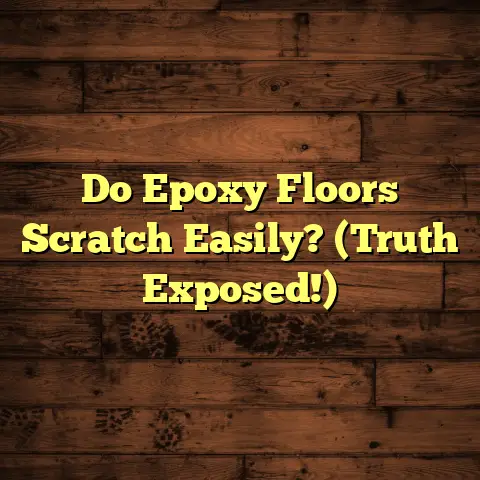Laminate Asbestos? How To Tell? (1 Telltale Sign!)
In the world of home improvement, safety is
always job number one.
And when it comes to
older homes, asbestos is a concern that often
pops up.
Imagine being able to quickly spot a potential problem and take action to protect your family.
That’s what we’re diving into today – uncovering
that one key sign that could indicate asbestos
lurking in your laminate.
Let’s get started!
Section 1: Understanding Laminate Flooring
So, what exactly is laminate flooring?
Simply put, it’s a multi-layer synthetic flooring
product fused together through a lamination
process.
Think of it like a high-tech sandwich.
Typically, you’ve got a base layer, a core board (often made of high-density fiberboard or HDF), a decorative layer with a printed image, and a tough, transparent wear layer on top.
Laminate’s popularity has exploded in recent
years, and for good reason!
It’s durable,
relatively inexpensive, and comes in a huge range
of styles that mimic hardwood, tile, and even stone.
It’s a fantastic option for budget-conscious homeowners who want a stylish look without breaking the bank.
The manufacturing process is pretty straightforward.
The layers are bonded together under high heat
and pressure.
These floors are used in living rooms,
bedrooms, kitchens, and even basements because
they are versatile and easy to maintain.
Section 2: The History of Asbestos in Flooring Materials
Now, let’s rewind a bit and talk about asbestos.
This naturally occurring mineral was once hailed
as a wonder material.
It’s strong, fire-resistant,
and readily available, so it found its way into
all sorts of construction products, including flooring.
Think back to the mid-20th century.
Asbestos
was everywhere – in floor tiles, adhesives,
insulation, and even cement.
It was valued for
its durability and heat-resistant properties.
However, the dark side of asbestos started to emerge as scientists discovered the serious health risks associated with inhaling its fibers.
Regulations began to tighten in the 1970s, and
the use of asbestos gradually declined.
But here’s
the catch: older homes may still contain materials
with asbestos.
Why are we talking about asbestos when this is about laminate flooring?
Well, sometimes older homes have layers upon
layers of flooring.
You might find laminate
installed over older asbestos-containing
materials like vinyl tiles or sheet flooring.
Plus, some early laminate-like products did
incorporate asbestos.
It’s rare, but it’s worth
being aware of.
Section 3: The Dangers of Asbestos Exposure
Okay, let’s get real about the risks.
Asbestos exposure can lead to some really serious health problems, including:
- Asbestosis: A chronic lung disease.
- Lung Cancer: A leading cause of death related to asbestos exposure.
- Mesothelioma: A rare and aggressive cancer that affects the lining of the lungs, abdomen, or heart.
The danger comes from inhaling tiny asbestos
fibers.
When these fibers get lodged in your lungs,
they can cause inflammation and scarring over time,
eventually leading to these diseases.
The latency period can be decades, meaning symptoms might not appear until years after exposure.
According to the World Health Organization (WHO), hundreds of thousands of people die each year from asbestos-related diseases.
It’s not just homeowners who are at risk.
Construction workers, demolition crews, and
anyone working with asbestos-containing materials
need to take precautions.
That’s why awareness is so important.
Knowing
the risks and how to identify potential asbestos
is the first step in protecting yourself and your
family.
Section 4: Identifying Laminate Flooring That May Contain Asbestos
Alright, so how do you figure out if your laminate flooring might be a concern?
First, let’s be clear: modern laminate flooring
is highly unlikely to contain asbestos.
The real
risk comes from older homes and potentially from
laminate installed over older flooring.
The age of your home is a big clue.
If your
house was built before the 1980s, there’s a
higher chance of finding asbestos-containing
materials somewhere.
Manufacturing practices are another factor.
As I mentioned earlier, some early laminate-like
products did use asbestos, though it’s not common.
Now, let’s get to the “telltale sign” I promised
you at the beginning.
This is something I’ve
seen time and time again in my years as a flooring
contractor.
Section 5: The Telltale Sign of Asbestos in Laminate Flooring
Okay, drumroll please… The telltale sign is this: The presence of 9×9 inch tiles underneath the laminate flooring.
Yes, you read that right.
If you peel back a
section of your laminate (maybe in a closet or
under a baseboard) and find 9×9 inch tiles
underneath, there’s a good chance those tiles
contain asbestos.
Why 9×9 inch tiles?
Because this was a very
common size for asbestos-containing floor tiles
manufactured for decades.
These tiles are usually solid colors or have
simple patterns.
They might be brittle and
easily crack or crumble.
I remember one job I did in an old Victorian
house.
The homeowner wanted to replace the
laminate in their kitchen.
When we started
pulling up the laminate, BAM!
There they were:
9×9 inch black tiles underneath.
We immediately
stopped work and called in an asbestos abatement
company.
Another time, I was helping a friend renovate
his basement.
He had laminate flooring he wanted
to replace.
Sure enough, under the laminate, we
found 9×9 inch speckled beige tiles.
We had
them tested, and they came back positive for
asbestos.
It’s important to note that not all 9×9 inch tiles contain asbestos, but it’s a strong indicator and warrants further investigation.
Don’t just assume they are safe. Always err on the side of caution!
Section 6: Next Steps for Homeowners
So, you’ve found the telltale sign – 9×9 inch
tiles under your laminate.
What do you do now?
First, don’t panic! Finding asbestos doesn’t
mean your house is a death trap.
It just means
you need to take some precautions.
Do not attempt to remove the flooring yourself.
This is crucial.
Disturbing asbestos-containing
materials can release fibers into the air, which
is exactly what you want to avoid.
The best thing to do is call a qualified asbestos abatement professional. They have the training, equipment, and expertise to safely test and remove asbestos-containing materials.
They will likely take a sample of the tiles and
send it to a lab for testing.
If the test comes
back positive for asbestos, they will develop a
remediation plan.
The remediation process usually involves sealing off the area, using specialized equipment to remove the asbestos-containing materials, and disposing of them properly.
It’s important to get multiple quotes from different abatement companies and check their credentials and insurance.
While you’re waiting for the professionals, avoid
disturbing the flooring as much as possible.
Don’t
sand, drill, or otherwise mess with it.
Section 7: Moving Forward with Confidence
Now that you’re armed with this knowledge, you can approach your home renovation projects with confidence.
Remember, awareness is key.
Knowing what to look
for and what steps to take can make all the
difference.
Don’t be afraid to ask questions and do your
research.
If you’re unsure about something, it’s
always best to consult with a professional.
And when it comes to choosing new flooring, there
are plenty of modern alternatives to traditional
laminate that are completely asbestos-free.
Look
for certifications and labels that guarantee the
product is safe and environmentally friendly.
You can find beautiful, durable, and safe flooring options that will give you peace of mind.
Conclusion: A Call to Action
So, there you have it – the one telltale sign that could indicate asbestos in your laminate flooring: 9×9 inch tiles underneath.
Being vigilant and informed is crucial for protecting your health and the health of your loved ones.
I encourage you to take a proactive approach in
your homes.
If you have older laminate flooring,
take a peek underneath (carefully!) and see if
you spot those 9×9 inch tiles.
Share this knowledge with your friends and family.
The more people who are aware of the risks of
asbestos, the safer we all are.
Remember, understanding and safety go hand-in-hand
in creating a healthy living environment.
You’ve
got this!





